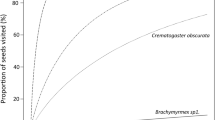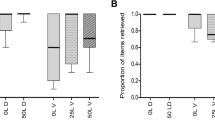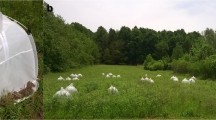Summary
In a study of the biochemical basis of seed dispersal by ants, elaiosomes of Acacia myrtifolia and Tetratheca stenocarpa induced seed collection: intact diaspores and elaiosomes were taken rapidly by ants while most seeds remained on the forest floor. Extracts of elaiosomes (non-polar lipids, polar lipids, and aqueous fractions) were differentially collected by ants. Small pieces of pith impregnated with the polar lipid fraction from elaiosomes of either species elicited a removal rate by ants equivalent to that of intact elaiosomes and significantly higher than that of untreated pith. The non-polar lipid fraction, highest in concentration in elaiosomes of both species, elicited removal that did not differ from that of untreated pith. In T. stenocarpa, however, the aqueous fraction also induced removal equivalent to the polar lipid fraction. 1,2-Diglycerides with unsaturated groups are present in the active polar fractions of both species and unsaturated oleate is the major acid group of the glycerides in elaiosomes. Most oleate-containing compounds tested were taken more rapidly by ants than saturated compounds, and oleic acid, associated with corpse-carrying in ants, induced rapid removal. 1,2-Diolein, but not 1,3-diolein, was taken suggesting that the specific configuration of fatty acid moieties influences collection by ants. We hypothesize that a small suite of oleyl-containing compounds in elaiosomes elicit a stereotyped carrying response by a variety of ants. While the nutrient composition of elaiosomes may provide the underlying selective advantage for ants in seed dispersal, specific compounds may manipulate their behaviour and maximize seed dispersal.
Similar content being viewed by others
References
Beattie AJ (1983) Distribution of ant-dispersed plants. Sonderbände des Naturwissenschaftlichen Vereins in Hamburg 71:421–427
Beattie AJ (1985) The evolutionary ecology of ant-plant mutualisms. Cambridge, Cambridge University Press
Beattie AJ, Culver DC (1980) The guild of myrmecochores in the herbaceous flora of West Virginia forests. Ecology 62:107–115
Berg RY (1975) Myrmecochorous plants in Australia and their dispersal by ants. Aust J Bot 23:475–508
Bond WJ, Slingsby P (1982) Seed dispersal by ants in shrublands of the Cape Province and its evolutionary implications. South Afr J Sci 79:231–233
Bresinsky A (1963) Bau, Entwicklungsgeschichte und Inhaltsstoffe der Elaiosomen. Bibliotheca Bot 126:1–54
Culver DC, Beattie AJ (1978) Myrmecochory in Viola: dynamics of seed-ant interactions in some West Virginia species. J Ecol 66:53–72
Dadd RH (1973) Insect nutrition: current developments and metabolic implications. Annu Rev Entomol 18:381–429
Dyke SF, Floyd AS, Sainsbury M, Theobald RS (1978) Organic spectroscopy An introduction, 2nd edn Longman, London
Finch PD (1983) Do rates need standardizing for comparative purposes? Biometrics 39:274–279
Gordon DM (1983) Dependence of necrophoric response to oleic acid on social context in the ant Pogonomyrmex badius. J Chem Ecol 9:105–111
Handel SN (1978) The competitive relationship of three woodland sedges, and its bearing on the evolution of ant dispersal of Carex pedunculata. Evolution 32:151–163
Hanzawa FM, Beattie AJ, Culver DC (1988) Directed dispersal: demographic analysis of an ant-seed mutualism. Am Nat 131:1–13
Haskins CP, Haskins EF (1974) Notes on the necrophoric behavior in the archaic ant Myrmecia vindex (Formicidae: Myrmeciinae). Psyche 81:252–267
Herrera C (1981) Are tropical fruits more rewarding to dispersers than temperate ones? Am Nat 118:896–907
Kennedy EP (1961) Biosynthesis of complex lipids. Fed Proc Am Soc Exp Biol 20:934–940
Lanza J (1988) Ant preferences for Passiflora nectar mimics that contain amino acids. Biotropica 20:341–344
Lanza J, Krauss BR (1984) Detection of amino acids in artificial nectars by two tropical ants, Leptothorax and Monomorium. Oecologia (Berlin) 63:423–425
Majer JD (1978) An improved pitfall trap for sampling ants and other epigaeic invertebrates. J. Aust Ent Soc 17:261–262
Marshall DL, Beattie AJ, Bollenbacher WE (1979) Evidence for diglycerides as attractants in an ant-seed interaction. J Chem Ecol 5:335–344
O'Dowd DJ, Gill AM (1986) Seed dispersal syndromes in Australian Acacia. In: Murray DR (ed) Seed dispersal. Academic Press, Australia, pp 87–121
O'Dowd DJ, Hay ME (1980) Mutualism between harvester ants and a desert ephemeral: seed escape from rodents. Ecology 61:531–540
Rice B, Westoby M (1981) Myrmecochory in sclerophyll vegetation of the West Head, New South Wales. Aust J Ecol 6:291–298
Vinson SB, Thompson JL, Green HB (1967) Phagostimulants for the imported fire ant Solenopsis saevissima richerti. J Insect Physiol 13:1729–1736
Welch RW (1977) A micro-method for the estimation of oil content and composition in seed crops. J Sci Food Agric 28:635–638
Wilson EO, Durlack NI, Roth LM (1958) Chemical releasers of necrophoric behaviour in ants. Psyche 65:108–114
Author information
Authors and Affiliations
Rights and permissions
About this article
Cite this article
Brew, C.R., O'Dowd, D.J. & Rae, I.D. Seed dispersal by ants: behaviour-releasing compounds in elaiosomes. Oecologia 80, 490–497 (1989). https://doi.org/10.1007/BF00380071
Received:
Issue Date:
DOI: https://doi.org/10.1007/BF00380071




